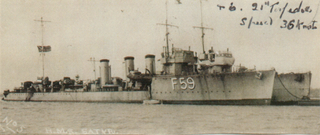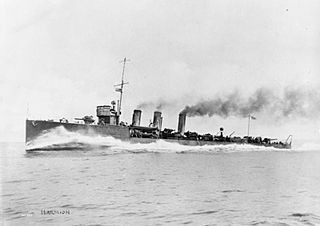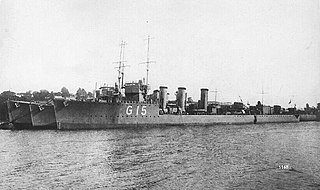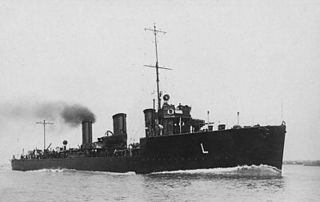HMS Starfish was an R-class destroyer which served with the Royal Navy. She was launched on 27 September 1916 and sold to be broken up on 21 April 1928. She was built by Hawthorn Leslie of Hebburn Tyne.

HMS Satyr was an R-class destroyer which served with the Royal Navy during the First World War. Launched on 27 December 1916, Satyr joined the Harwich Force under the command of Commander Hubert de Burgh. In 1917, the destroyer formed part of a force protecting the monitors Erebus and Terror in their bombardment of Ostend. As part of this action, Satyr, along with sister ships Taurus, Sharpshooter and Torrent, sank the German destroyer S20. After the war, the ship served with the Torpedo School at the Devonport. In 1923, the Navy decided to retire many of the older destroyers in preparation for the introduction of newer and larger vessels and Satyr was sold to be broken up on 16 December 1926.

HMS Ulster was a modified Admiralty R-class destroyer that served in the Royal Navy during the First World War. The Modified R class added attributes of the Yarrow Later M class to improve the capability of the ships to operate in bad weather. Launched on 10 October 1917, the vessel served with the Grand Fleet. After the war, the destroyer was placed initially in the Home Fleet, but then moved to the Reserve Fleet before, on 21 April 1928, being sold to be broken up.

HMS Radstock was the first in a class of 62 R-class destroyers. The design differed from the preceding M-class primarily in the use of geared turbines, which gave better fuel efficiency. The ship was launched in 1916 and served with the Grand Fleet of the Royal Navy during World War I as in an escort and anti-submarine role. While escorting a convoy in 1918, the destroyer collided with the merchant ship Volute, but otherwise had an uneventful war. After the Armistice of 11 November 1918 that ended the war, the vessel was recommissioned with reduced complement and joined the Reserve Fleet. Radstock stayed in Reserve until 1927. By this time, the vessel had deteriorated and, despite having a refit in 1925, was deemed unfit for service and was sold to be broken up.

HMS Sharpshooter was an R-class destroyer which served with the Royal Navy during World War I. Launched on 27 February 1917, the ship joined the Harwich Force, undertaking convoy escort duties. The vessel also took part in the Navy’s bombardment of Ostend later that year. On 1 June 1918, the destroyer rescued Captain A. C. Sharwood, one of the first pilots of the Royal Australian Navy, who ditched his Sopwith 2F.1 Camel nearby. After the war, Sharpshooter joined the Navy gunnery training establishment at Plymouth, but did not stay long and was reduced to Reduced Complement on 5 March 1919. The Royal Navy was rationalising its destroyer force and Sharpshooter, deemed superfluous, was sold to be broken up on 29 April 1927.

HMS Simoom was an S-class destroyer which served with the Royal Navy. Launched on 26 January 1918, the vessel operated as part of the Grand Fleet during the last months of World War I. At the end of the conflict, Simoom was placed in reserve and scrapped on 8 January 1931. The name was reused from an R-class destroyer sunk on 23 January 1917.

HMS Sarpedon was an R-class destroyer which served with the Royal Navy. The R class were a development of the preceding M-class, but differed in having geared turbines and other design changes. Launched in June 1916, the vessel escorted convoys that sailed between Scotland and Scandinavia in the First World War. After the war, the ship was allocated to local defence at Nore. However, in 1923, the Navy decided to retire many of the older vessels and Sarpedon was retired and was sold to be broken up on 23 June 1926.

HMS Nereus was a Admiralty M-class destroyer which served with the Royal Navy during the First World War. Launched in 1916, the vessel served with the Grand Fleet until the end of the conflict. The vessel operated as part for Thirteenth Destroyer Flotilla in support of convoy operations. In 1918, the flotilla took part in one of the last sorties of the war, although the British and German fleets did not meet and the destroyer returned without seeing any action. After the conflict, the destroyer was worn out by the demands of high speed operation in poor weather. Nereus was decommissioned and sold to be broken up in 1921 after less than six years service.

HMS Romola was an R-class destroyer which served with the Royal Navy during World War I. Launched on 14 May 1916, the ship operated as part of the Grand Fleet, operating as part of a destroyer flotilla. The ship sailed to intercept the German High Seas Fleet in what would be one of the last major expeditions of their Navy in the war but saw no action. After the conflict, the destroyer was held in reserve until being retired and sold to be broken up on 13 March 1930.

HMS Llewellyn was a Laforey-class destroyer that served with the Royal Navy. Laid down on 14 December 1912 as HMS Picton, the ship was renamed on 30 September 1913 under an Admiralty order to become one of the first alphabetical class destroyers, being launched on 30 October. On commissioning, the vessel joined the Third Destroyer Flotilla and operated as part of the Harwich Force during the First World War. The destroyer took part in the Battle of Heligoland Bight, as well as undertaking anti-submarine patrols and escort duties. It was during one of these patrols on 4 December 1916 that the vessel unsuccessfully attacked the German submarine UB-18. On 17 March 1917, the destroyer was struck in the bow by a torpedo launched by a German torpedo boat while rescuing survivors from the sunk destroyer Paragon, but returned to port safely by steaming backwards. With the cessation of hostilities, the ship was placed in reserve. Although subsequently offered for sale to the Finnish Navy, Llewellyn was instead withdrawn from service and sold to be broken up on 18 March 1922.

HMS Tactician was an S-class destroyer, which served with the Royal Navy. Launched on 7 August 1918, the vessel entered service at the closing of the First World War. The ship joined the Fourteenth Destroyer Flotilla of the Grand Fleet but was placed in Reserve at Nore in 1919. Tactician deteriorated over the following years and was sold to be broken up on 5 February 1931 following the signing of the London Naval Treaty that limited the amount of destroyer tonnage that the Navy could retain.

HMS Trinidad was an S-class destroyer that served with the Royal Navy. The ship was named after the island in the West Indies. Launched on 8 May 1918, the vessel entered service with the Grand Fleet but saw no action during the First World War. After the Armistice, Trinidad joined the Mediterranean Fleet. War had broken out between Greece and Turkey and there was intelligence that the Soviet Union was selling warships to one of the belligerents. Trinidad was part of a small flotilla that was sent to investigate and, ultimately, halt this trade. However, it turned out to be a hoax. The destroyer subsequently returned to Constantinople. In 1930, the signing of the London Naval Treaty required the Royal Navy to retire older destroyers before acquiring new ones. Trinidad was one of those chosen for retirement and, on 16 February 1932, the destroyer was sold to be broken up.

HMS Pellew was a Admiralty M-class destroyer which served with the Royal Navy during the First World War. The M class were an improvement on the preceding L class, capable of higher speed. Launched on 18 April 1916, the vessel served with the Grand Fleet escorting convoys. The vessel was part of an unsuccessful attempt by the navy to trap the German submarines that had taken such a heavy toll on merchant shipping in December 1917. The action involved an eight-ship convoy consisting of four merchant vessels escorted by two armed trawlers and the sister ships Pellew and Partridge. Instead of submarines, four German destroyers attacked, sinking all but one member of the convoy and disappearing before the light cruisers which were to be the spring in the trap could arrive. Pellew, the sole survivor, took refuge in a Norwegian fjord. After the armistice that ended the war, the destroyer was placed in reserve and subsequently sold to be broken up on 9 May 1921.

HMS Pelican was a Admiralty M-class destroyer which served with the Royal Navy during the First World War. The M class were an improvement on the preceding L class, capable of higher speed. Launched on 18 March 1916, the vessel served with the Grand Fleet, taking part in significant actions on 19 August 1916 and 4 May 1917, as well as the fight between the British and German battlecruisers in the Battle of Jutland. The destroyer also undertook the other more general roles were typical of the type, including anti-submarine sweeps and escort duties for convoys. The destroyer had success driving away German submarines but did not sink any. After the end of the war, Pelican initially joined a Local Defence Flotilla but within a year had been placed in reserve and was subsequently sold to be broken up on 9 May 1921.

HMS Peregrine was a Admiralty M-class destroyer that served with the Royal Navy during the First World War. The M class were an improvement on the preceding L class, capable of higher speed. Launched on 29 May 1916, the vessel served with the Grand Fleet, focusing on anti-submarine warfare. In 1917, the destroyer was involved in the search for UC-65 after the submarine had sunk the protected cruiser Ariadne. In 1918, the ship participated in one of the final sorties of the war, although this did not lead to a confrontation with the German High Seas Fleet. After the Armistice that ended the war, the destroyer was placed in reserve and subsequently sold to be broken up on 9 May 1921.

HMS Mons was an Admiralty M-class destroyer which served with the Royal Navy during the First World War and fought in the Battle of Jutland. The M class was an improvement on the preceding L class, capable of higher speeds. The ship, the first British naval vessel to be named after the Battle of Mons, was launched in 1915. Joining the Grand Fleet as part of the new Eleventh Destroyer Flotilla, the destroyer was soon in action, taking part in patrols that aimed to draw out the German High Seas Fleet. During the Battle of Jutland in 1916, Mons attacked the German light cruisers at the forefront of the German battleline but scored no hits. After the armistice, the destroyer was placed in reserve. Mons was found to be worn out by wartime operations and, despite only serving for six years, in 1921, was sold to be broken up.

HMS Tancred was an R-class destroyer which served with the Royal Navy during the First World War. The R class were an improvement on the previous M class with geared steam turbines to improve efficiency. Launched by Beardmore of Dalmuir on 30 June 1917, Tancred initially joined the Grand Fleet, serving as part of a flotilla that took part in one of the last naval actions of the war, although in this case the British vessels did not engage with the German High Seas Fleet. After the signing of the Armistice that ended the war and the dissolution of the Grand Fleet, the destroyer was initially transferred to the Home Fleet. However, within a year, Tancred had been allocated to the local defence flotilla at Firth of Forth. Despite being at a reduced complement as an economy measure, further reductions in fleet costs meant that the destroyer was retired. On 17 May 1928, Tancred was sold to be broken up.

HMS Orford was an Admiralty M-class destroyer which served in the Royal Navy during the First World War. The M class were an improvement on the previous L-class, capable of higher speed. The vessel was launched on 19 April 1916 and joined the Grand Fleet. Orford spent much of the war undertaking anti-submarine warfare patrols and escorting convoys across the Atlantic Ocean. Although based at Scapa Flow, the destroyer ranged far, often operating off the coast of Cornwall and even having a temporary transfer to Buncrana in Ireland in 1917. In 1918, the destroyer took part in one of the final sorties of the Grand Fleet, but saw no action. After the Armistice that marked the end of the First World War, Orford was placed in reserve, decommissioned and, on 31 October 1921, sold to be broken up.

HMS Octavia was an Admiralty M-class destroyer which served in the Royal Navy during the First World War. The M class were an improvement on the previous L-class, capable of higher speed. The vessel was launched on 21 June 1916 and joined the Grand Fleet. Octavia joined the Thirteenth Destroyer Flotilla, which, in 1917, participated in a large anti-submarine warfare operation in the North Sea. The sortie led to three German submarines being sunk, although Octavia was not directly involved in these attacks. In 1918, the flotilla was involved in one of the final sorties of the Grand Fleet, but again the destroyer saw no action at the time. After the Armistice that marked the end of the First World War, Octavia was placed in reserve, decommissioned and, on 5 November 1921, sold to be broken up.

HMS Oberon was a Repeat Admiralty M-class destroyer which served in the Royal Navy during the First World War. The M class were an improvement on the previous L-class, capable of higher speed. The vessel was launched in 1916 and joined the Grand Fleet. Oberon joined the Thirteenth Destroyer Flotilla which, in 1917, participated in a large anti-submarine warfare operation in the North Sea. The sortie led to three German submarines being sunk, although Oberon was not directly involved in these attacks. In 1918, the flotilla was involved in one of the final sorties of the Grand Fleet, but again the destroyer saw no action at the time. After the Armistice that marked the end of the First World War, Oberon was placed in reserve, decommissioned and, in 1921, sold to be broken up.












